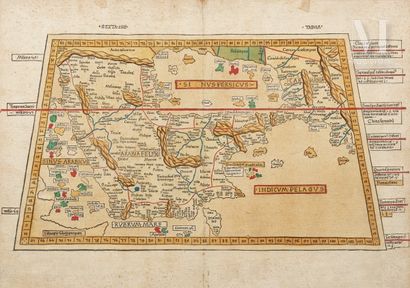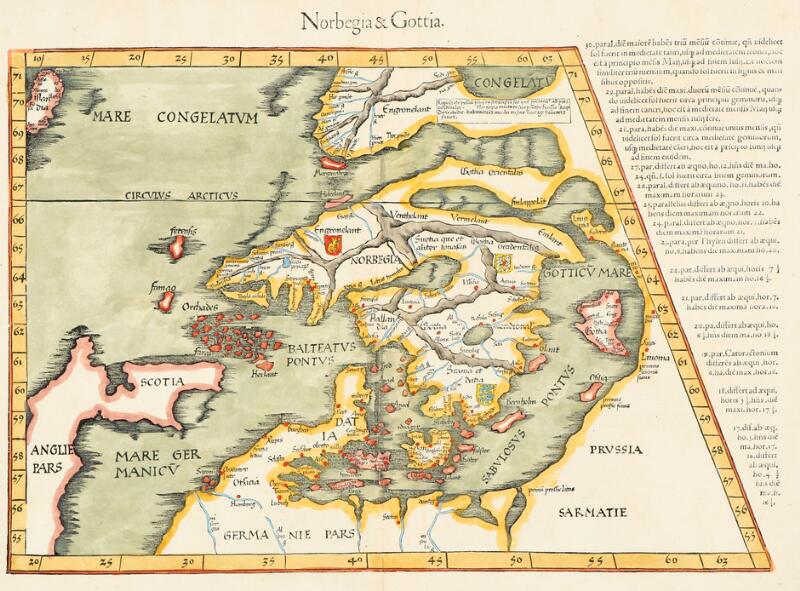MARTIN WALDSEEMÜLLER (c.1470 - c.1522). World map in the form of a set of terrestrial globe gores. St. Dié: 1507.] A set of 12 woodcut gores for a terrestrial globe with a diameter of 12cm (4½ inches), overall maximum dimensions of the paper 180 x 344mm, trimmed to the margin of the gores. (Some light staining, two small clean tears in the joins between gores 10 and 11 and 11 and 12, traces of old folds along gore joins, old vertical paste mark at gore 6/7.) A SIGNIFICANT MILESTONE IN THE MAPPING OF THE WORLD. ONE OF FOUR KNOWN COPIES, THE ONLY SEPARATELY PUBLISHED MAP BY WALDSEEMüLLER IN PRIVATE HANDS. WALDSEEMüLLER'S GLOBE MAP IS A MAP OF MANY FIRSTS: THE FIRST PRINTED GLOBE, THE FIRST 'ACCURATE AND COMPLETE' MAP OF THE WORLD IN 360°, THE FIRST MAP OR GLOBE TO NAME AMERICA, THE FIRST TO SHOW A SEPARATE SOUTH AND NORTH AMERICAN CONTINENT, THE FIRST TO SHOW THE PACIFIC OCEAN AS A SEPARATE ENTITY, THE FIRST TO SHOW CAPE HORN AND A DEFINED WESTERN COASTLINE TO SOUTH AMERICA. This globe map and Waldseemüller's large wall map (the only extant example now owned by the Library of Congress, U.S.A.), both first published in 1507, became the basis of all world maps and globes for the next 35 years. They presented a new revolutionary global geography, completing the fourth quadrant of the world. The globe map was drawn up by Martin Waldseemüller in St. Dié, Lorraine, south west of Strasbourg. It was issued with the Universalis Cosmographia large wallmap, and a booklet, Cosmographiae Introductio , the three parts often described as the 'Birth Certificate of America'. THE GENESIS OF THE WALDSEEMüLLER GORES Martin Waldseemüller, theologian and cosmographer, and Matthias Ringmann, a humanist poet, were brought to the monastery of St. Dié des Vosges in early 1505 by Gualtier Ludd, Secretary to René II Duke of Lorraine, to join a group of scholars called the Gymnasia Vosagense. Waldseemüller and Ringmann started work on a new edition of Ptolemy's Geographia that was to combine Ptolemaic maps with a new set of modern maps. They were provided with at least six printed editions and certainly several manuscript versions of the Geographia . Their work on this new Geography of the World was combined with an instruction to create a new globe and large map of the world, for which René had received a French translation of Amerigo Vespucci's voyages, and for which they must have also had copies of Portuguese charts either from Portugal or from Italy. Ringmann, a supporter of Vespucci, had already published in 1505 an edition of Vespucci's Mundus Novus , a 'vivid' description of the New World which became a 'bestseller' around Europe. By April 1507, Waldseemüller and Ringmann had completed the booklet, Cosmographiae Introductio , to accompany the globe and wallmap. It appeared in two editions in St. Dié, the first in April 1507 (2 issues) and in again in August 1507. Another edition was published by Waldseemüller alone in 1509 in Strasbourg. The Cosmographiae provided an introduction to the new geography of the world as laid out in the globe and wallmap, and included a Latin translation of Vespucci's four voyages. In the text, the authors explain the reasons for the naming of 'America': ' Now, these parts of the earth have been more extensively explored and a fourth part has been discovered by Amerigo Vespucci. Inasmuch as both Europe and Asia received their names from women, I see no reason why any one should justly object to calling this part Amerige, i.e., the land of Amerigo, or America, after Amerigo, its discoverer, a man of great ability '. Although it is likely that the simple globe gores, their model or 'marquette' of the New World view, would have been available with each issue of the Cosmographiae , the large 12 sheet wallmap, would have been too expensive to be sold as widely. Although a text on Waldseemüller's later wallmap, the Carta Marina (1516), says that 1,000 copies of the 1507 wallmap were made, it is unlikely that this number
MARTIN WALDSEEMÜLLER (c.1470 - c.1522). World map in the form of a set of terrestrial globe gores. St. Dié: 1507.] A set of 12 woodcut gores for a terrestrial globe with a diameter of 12cm (4½ inches), overall maximum dimensions of the paper 180 x 344mm, trimmed to the margin of the gores. (Some light staining, two small clean tears in the joins between gores 10 and 11 and 11 and 12, traces of old folds along gore joins, old vertical paste mark at gore 6/7.) A SIGNIFICANT MILESTONE IN THE MAPPING OF THE WORLD. ONE OF FOUR KNOWN COPIES, THE ONLY SEPARATELY PUBLISHED MAP BY WALDSEEMüLLER IN PRIVATE HANDS. WALDSEEMüLLER'S GLOBE MAP IS A MAP OF MANY FIRSTS: THE FIRST PRINTED GLOBE, THE FIRST 'ACCURATE AND COMPLETE' MAP OF THE WORLD IN 360°, THE FIRST MAP OR GLOBE TO NAME AMERICA, THE FIRST TO SHOW A SEPARATE SOUTH AND NORTH AMERICAN CONTINENT, THE FIRST TO SHOW THE PACIFIC OCEAN AS A SEPARATE ENTITY, THE FIRST TO SHOW CAPE HORN AND A DEFINED WESTERN COASTLINE TO SOUTH AMERICA. This globe map and Waldseemüller's large wall map (the only extant example now owned by the Library of Congress, U.S.A.), both first published in 1507, became the basis of all world maps and globes for the next 35 years. They presented a new revolutionary global geography, completing the fourth quadrant of the world. The globe map was drawn up by Martin Waldseemüller in St. Dié, Lorraine, south west of Strasbourg. It was issued with the Universalis Cosmographia large wallmap, and a booklet, Cosmographiae Introductio , the three parts often described as the 'Birth Certificate of America'. THE GENESIS OF THE WALDSEEMüLLER GORES Martin Waldseemüller, theologian and cosmographer, and Matthias Ringmann, a humanist poet, were brought to the monastery of St. Dié des Vosges in early 1505 by Gualtier Ludd, Secretary to René II Duke of Lorraine, to join a group of scholars called the Gymnasia Vosagense. Waldseemüller and Ringmann started work on a new edition of Ptolemy's Geographia that was to combine Ptolemaic maps with a new set of modern maps. They were provided with at least six printed editions and certainly several manuscript versions of the Geographia . Their work on this new Geography of the World was combined with an instruction to create a new globe and large map of the world, for which René had received a French translation of Amerigo Vespucci's voyages, and for which they must have also had copies of Portuguese charts either from Portugal or from Italy. Ringmann, a supporter of Vespucci, had already published in 1505 an edition of Vespucci's Mundus Novus , a 'vivid' description of the New World which became a 'bestseller' around Europe. By April 1507, Waldseemüller and Ringmann had completed the booklet, Cosmographiae Introductio , to accompany the globe and wallmap. It appeared in two editions in St. Dié, the first in April 1507 (2 issues) and in again in August 1507. Another edition was published by Waldseemüller alone in 1509 in Strasbourg. The Cosmographiae provided an introduction to the new geography of the world as laid out in the globe and wallmap, and included a Latin translation of Vespucci's four voyages. In the text, the authors explain the reasons for the naming of 'America': ' Now, these parts of the earth have been more extensively explored and a fourth part has been discovered by Amerigo Vespucci. Inasmuch as both Europe and Asia received their names from women, I see no reason why any one should justly object to calling this part Amerige, i.e., the land of Amerigo, or America, after Amerigo, its discoverer, a man of great ability '. Although it is likely that the simple globe gores, their model or 'marquette' of the New World view, would have been available with each issue of the Cosmographiae , the large 12 sheet wallmap, would have been too expensive to be sold as widely. Although a text on Waldseemüller's later wallmap, the Carta Marina (1516), says that 1,000 copies of the 1507 wallmap were made, it is unlikely that this number

.jpg?height=400)
.jpg?w=400?width=1600&quality=70)




.jpg)







Testen Sie LotSearch und seine Premium-Features 7 Tage - ohne Kosten!
Lassen Sie sich automatisch über neue Objekte in kommenden Auktionen benachrichtigen.
Suchauftrag anlegen